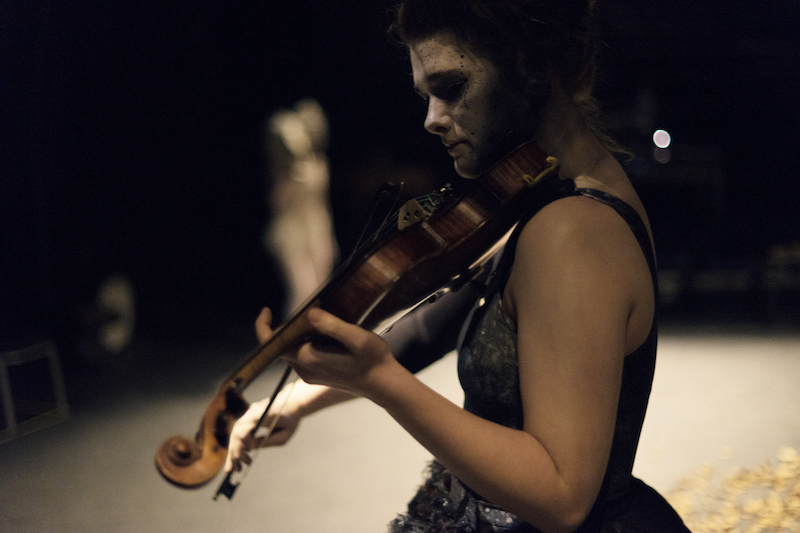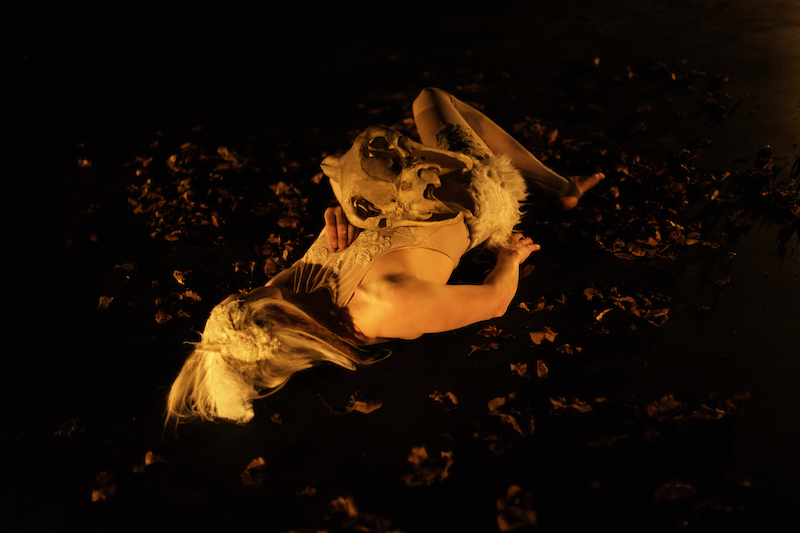Wickham Theatre, All Hallows Hall and The Island, Circus City Festival, Bristol; 21st, 22nd, and 23rd October 2015

Ziggy Slingsby has created an intriguing proposition with the trilogy of Original, Raw and Encounter – three versions of her Two-Legged Animal show – which each offer a different way to experience the equine embodiment that bases the trio of work. How do you choose between them? Or do you see them all? How will one influence your reception of another?
Each piece contains the motif of a girl, cradling a horse’s skull, which cracks open like an egg, birthing the spirit of the animal into the room. The sometimes grotesque, sometimes eerily natural movements of this horse-woman have evolved through the Butoh mentorship of Holly Holt, and are startlingly effective in summoning the ghost of a once-loved animal. Rob Tannion’s dramaturgy has constructed a dreamlike coherence.
Encounter is an intimate one-to-one experience that requires no aerial rigging, while Raw and Original are both set in the almost-round of a modern circus ring, audience on wooden benches, a rope rigged from a central truss, with live atmospheric song and sound from violinist Rowan Rheingans. Original is the slicker package, with elaborate costumes and theatrical lighting shifts, while Raw is more open, with a flexibility in its structure for improvisation amongst the audience.

The first part I see is Original, which has, with the freshness of complete novelty, left the biggest impression on me. I would love to know how my conception of the trilogy would have differed had I seen the pieces in a different order. As it is, the intricate costumes that nod to bygone traditions of circus and equine performance, the slow dawning of realisation that Slingsby is at once herself, and a remembered companion, and the aerial rope work that further blurs the boundaries between horse and human, memory and present moment, form the fullest sense for me of what Two-Legged Animal can signify.
Entering the Wickham Theatre’s black box studio space to the long scratched notes of Rheingans’ fiddle and a scattering of autumn leaves over a marked circular playing space, I see a girl dressed in shades of bone, shouldering the skull of a horse. With slow, careful steps, she paces out the circle, like a lunged animal at a riding school. The faded feathers on Slingsby’s head are a nod to the ghost of circuses past, with their plumed troupes of ponies, as well as a practical device to style her own hair into a side-mane.
As humans, we excel in creating anthropomorphic images from objects and creatures around us; to see the reverse is a strange delight that almost feels as though some shamanic magic is at work.

Slingsby the horse picks up pace, running, stumbling, dying. Slingsby the girl cradles the skull until it fractures, and then emerges as a new, ungainly creature, learning to move. The lights blackout, the skull is taken offstage, the rope is lowered to hang from the ceiling. Rheingans leaves her fiddle, and crosses to a second, also suspended from the ceiling. She puts on a pair of clogs, which will form the beats of a horses feet at moments throughout the rest of the show.
We hear the sounds that horses make when approaching each other as Slingsby moves towards the rope. I am intrigued to see how a horse and a rope commune. Usually an instrument to tether, but used by corde lisse artists as a platform for freedom of expression… Again, two states seem to exist at once, unfixed. Unfolding at the slow pace of the past, Slingsby’s routine on the rope transforms it into a place of comfort – a stand-in for the lost horse of her dreams. Every touch is filled with loving care and trust. But the rope can drop her too, and the next time she climbs, it is as the horse, breathing deeply through the nose, exploring a tentative connection, uncertain now, and skittish, while Rheingold drums out a tense rhythm with her feet.

The memory I’m watching now seems to be the recollection of the horse, being broken in for the first time, dashing across the stage with the rope still attached around her waist. An uneasy sense of calm descends with the plucking of the violin. A grudging acceptance. The ghost is laid once more, to be summoned back by Rheingans’ humming. Now neither one creature or another, this contorted hybrid paws for purchase at the ground, then finds itself at the rope once more. Leaves fall, the rope is climbed, with vocals and galloping footfall leading towards a sense of closure. The horse may be gone, but its spirit lives on in the rope. Slingsby climbs into the blackness above our heads, Rheingans leaves the stage, and the rope coils down to the ground alone, empty now of the life we have imagined for it over the last 45 minutes.
The next night, I head to the community circus venue of All Hallows Hall, with its frescoed ceilings and large open space, marked with a ring of soil and the same scattered leaves as yesterday. I feel acutely aware of my own noise taking my seat. The hush seems a palpable force. Raw has a different aesthetic, but the material seems to be a reprise of Original, with a looser structure to allow for more development of improvised impulses. In this version I lose sight of the girl and see only horse, despite the more pedestrian costuming of grey practise leggings and polo neck, snipped into manufactured tears that reveal flashes of the lace leotard beneath. I find myself watching Slingsby’s physicalisations rather than absorbing new meaning, unable to remove myself from the understanding I’ve already gained from seeing the previous version. I suddenly see the final contorted physiology, with head thrown back as far as it will go, become the headless horse spectre searching for the skull that called its spirit to life. And yet the idea of nostalgia does not seem present here. The eye contact and immediacy of the horse among us, with its spontaneous reactions to our presence, is stronger in the all-encompassing lighting state. And, of course, I am more au fait now with the convention of seeing Slingsby as horse.

Which leads to me to Encounter. Having seen the first two instalments, I was expecting to meet Slingsby in equine-form, but was unsure how this would be approached. The slow emergence from the skull-egg seems gentle enough to give its single audience member time to acclimatise to the experience of being alone in a room with this intense incarnation. In this case, the room has the dark wooden inlay floor that I associate with my primary school hall, and a large tiled fireplace in one of the blank walls; the windows, curtained with drapes of crushed velvet, add to the feelings of history and things long past, but look out onto the sights and clanging sounds of a building site. This clash of eras sit well with the notion that the horse I meet is a living memory, adrift in time.
I know the moves by now and, up close, find myself fascinated by details – her feet, the curve of instep and calf, the flexed toes. The intensity of her eye contact is more extreme when it reaches out for me suddenly from an inverted pose. Later on, a smile is a surprise, as this is the first I’ve seen cross her face in three shows.
I was that child who liked to think I could commune with the animals, and I enjoy the challenge of trying to win this creature’s trust by subtlety. Nevertheless, I’m aware of an underlying temptation to tease, what happens if I spook her? It’s a recognition of the performer beneath – how would Slingsby react as the animal in that situation – but, true to my nature I suppose, I gain more satisfaction in feeling that I’ve established a comfortable coexistence. When she comes to stand close by me, I put my hand on her shoulder, but stop short of stroking.
The end of the piece is unclear. I hear a knock at the door, but don’t know if that means I need to leave. I want to stay longer. See all this can be. I want to watch again. To watch others watching, and see what changes. But the performer in front of me no longer seems to be performing. I think my 15 minutes are over. But I will keep thinking about this Encounter, what I saw in her, and in me, for a long time.

The order in which I watched the pieces no doubt contributes to my understanding of the trilogy as a whole, and I would suggest that the three-show format is designed to offer the work to different markets, rather than for all to be seen by the same audience. Encounter can sit nicely alongside either the Raw or Original treatments, but I’m not sure there is anything additional to be gained from seeing both of the longer pieces. Not in such close proximity anyway. Give it another few months and I’ll be ready to try again, in a different order this time!
.
.





Sounds incredible! Jx